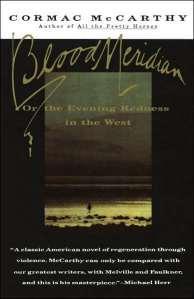***
Blood Meridian, or the Evening of Redness in the West
 Author: Cormac McCarthy
Author: Cormac McCarthy
First Edition: 1985
Original language: English
I read this book after literally dozens of people suggested it after reading my post on 10 Disturbing Novels. This book was unquestionably disturbing, but not I can’t put it down disturbing, more like I can’t believe someone could write something so violent disturbing. I did not enjoy this read.
I actually hated myself for my habit –obsession? – of finishing every book I start, no matter how much I dislike it. Ok, ok, I did put down Fifty Shades of Grey after about 100 pages, but come on- there is only so much torture I can take. So at least I liked this book more than Fifty Shades, but that’s not saying much and is an insult to McCarthy- and anyone else who can write a sentence.
The fact that I didn’t like the violence- especially the violence against animals- does not mean that the book was not brilliantly written. It was just definitely not my cup of tea. I can, however, appreciate that telling this story in a violent way is the only way to relate the horror of the historic events that the novel portrays.
Through the eyes of “the kid,” a 14-year-old youth from Tennessee, the reader is able to experience the realities and horrors of America’s westward expansion, namely, those perpetrated by the real-life Glanton gang, a group of scalp hunters who terrorized the U.S.- Mexico border in the early 1850s.
By telling the story of westward expansion through a very different lens, McCarthy challenges the often-romanticized world of the “wild west” and westward expansion.
McCarthy employs a unique writing style that has no quotation marks and uses archaic words (thank heavens for Kindle!). However, it is not off-putting to the reader.
McCarthy’s descriptions of the western landscape and the utter solitude and brutality of nature and the elements were superbly written. Some of his descriptions made me feel like I was in a Fredric Remington or Charles M. Russell painting- then the blood and guts and gore would start flying and I would remember what I was reading.
There are several reports about McCarthy’s extensive research for this novel. To write it, McCarthy traveled to all the places mentioned and is said to have learned Spanish to give the language more authenticity.
Judge Holden is the character that has garnered the most attention. Some describe him as a biblical character, the personification of war, Captain Ahab from Moby Dick. He reminded me of Kurtz in Heart of Darkness, because the members of the gang both revered and feared him, probably because they could not understand him.
Glanton is another interesting character, based on the real John Joel Glanton (1819 – April 23, 1850). However, while the judge seems to have some albeit strange reason for his violence, Glanton is just a savage who likes to kill. Throughout the novel, the only creature he shows compassion for is his dog- and even then, he’s not so nice to the dog.
While reading, it is easy to think that the kid is not as bloodthirsty and brutal as the other members of the gang, but he is just as bad, having killed way before he joined them.
Quotes:
“There is no such joy in the tavern as upon the road thereto,”
“Here beyond men’s judgments all covenants were brittle.”
“The man who believes that all the secrets of the world are forever hidden lives in mystery and fear. Superstition will drag him down. The rain will erode the deeds of his life. But that man who sets himself the task of singling out the thread of order from the tapestry will by the decision alone have taken charge of the world and it is only by such taking charge that he will effect a way to dictate the terms of his own fate.”
“It makes no difference what men think of war, said the judge. War endures. As well ask men what they think of stone. War was always here. Before man was, war waited for him. The ultimate trade awaiting its ultimate practitioner. That is the way it was and will be. That way and not some other way.”
